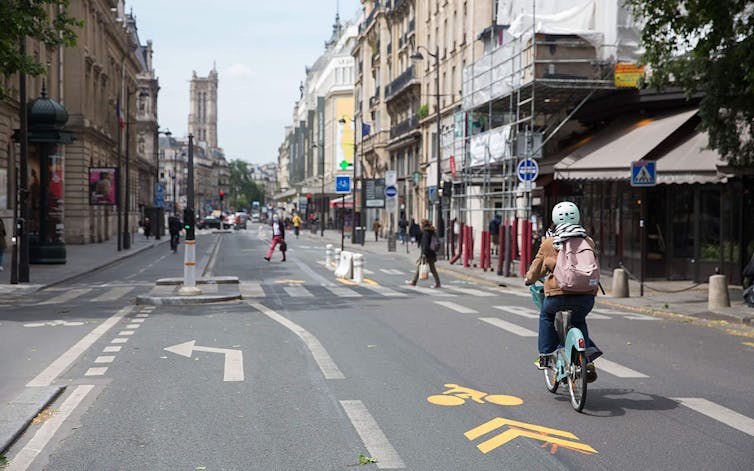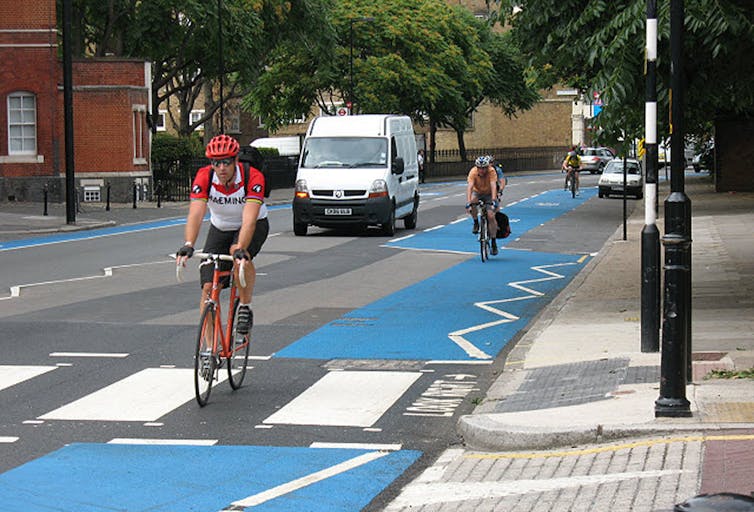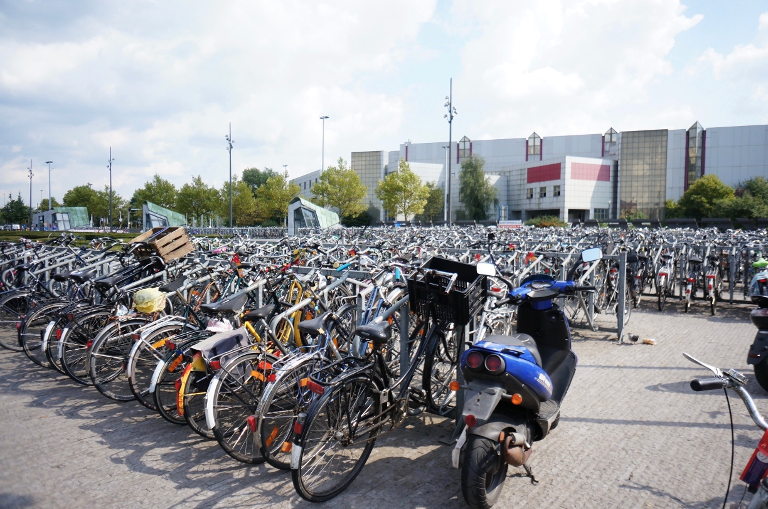
Mairie de Paris
Hélène Duranton, SKEMA Business School
This article was co-written by Philip Adkins, cycling writer and consultant.
When the Covid-19 pandemic broke out in 2019-20, it had an immense impact around the world, but particularly in urban areas, where it was particularly transmissible. Lockdowns and curfews were imposed, as well as distance work and remote learning, in an attempt to reduce infection rates. As car and plane travel dropped precipitously, air quality improved unintentionally due to an “unprecedented decline in CO2 emissions”. At the same time, because cycling was a form of “safe mobility”, leading cities created “pop-up” cycling lanes to encourage socially distanced mobility.
The result was an unprecedented bike boom around the world. It was in part enabled by bike-sharing systems that began to spread in the 2000s as well as technological innovations such as electric bikes. The sudden emphasis on low-pollution, active transportation has permitted cities to move closer to pollution reduction targets – the UK has targeted an 80% reduction in emissions by 2050, while France is seeking carbon neutrality in 2050.
The gold standard for active transportation has long been the cities of Amsterdam and Copenhagen, where cycling is embedded in the culture. So much so that to “Copenhagenize” is now a common term among promoters of urban cycling. While it is easy to assume that this is cultural and has always been the case, Amsterdam only committed to improving cycling access during the 1970s.
Bringing about transportation and lifestyle change is achievable, but requires political will and public support. Other examples of significant cultural changes in shorter periods of time include the compulsory use of seatbelts in cars and the prohibition of smoking in public buildings. Amsterdam and Copenhagen present high standards by which to judge other cities, but if the growth in cycling is to be safe and sustainable, standards must be high.
How Covid-19 has helped cities shift to active transportation
Three leading cities – London, Paris and New York – have all seized on the Covid-19 pandemic as an opportunity to make improvements to their cycling infrastructure to improve mobility, reduce congestion and cut pollution. While these cities are distinct, how do their cycling infrastructures compare?

Geograph.org.uk
London
The introduction of a number of “cycling superhighways” in London over the past few years has expanded segregated cycling facilities, while routes on existing roads have improved user safety. The addition of temporary cycling lanes could help link these existing facilities together, to provide a convenient and comprehensive cycling plan for London.
The UK transport secretary, Grant Shapps, has promoted cycling during lockdown and as a legacy of the pandemic, stating:
“Millions of people have discovered cycling – whether for exercise or as a means of safe, socially-distanced transport. While there is no change to the ‘stay at home’ message today, when the country does get back to work we need those people to stay on their bikes and be joined by many more.”
To support this goal, in May 2020 the government established a £250 million emergency active travel fund, kept bicycle shops open, and issued £50 bicycle repair vouchers to encourage people to cycle. The mayor of London, Sadiq Khan, is aiming to have 80% of journeys be made by foot, bike or on public transport by 2041. A key element of the program, known as Streetspace, is the construction of a “strategic cycling network, using temporary materials”. The intention is for changes to become permanent fixtures, accommodating a projected 10-fold increase in cycling.

Chris93/Wikimedia, CC BY
Paris
Long an advocate of reducing car traffic in Paris, mayor Anne Hidalgo has recognised the danger of air pollution in conjunction with the coronavirus, calling the combination “a dangerous cocktail”.
During her first term in office she spearheaded a significant increase in cycling-specific infrastructure. The Rue de Rivoli, which runs east-west through the heart of the city, was already reconfigured to reduce traffic and prioritise cycling. When the pandemic broke out, what was already the equivalent of one of London’s “cycling superhighways” was doubled in width, removing an entire lane once dedicated to car traffic. The long-term goal is that even when the pandemic ends, the pop-up cycling lanes will become permanent.
The city has also introduced €500 subsidies for the purchase of E-bikes and €50 reimbursements for bike repairs.
New York
New York would not perhaps be the first city to come to mind as being cycle-friendly. However, even prior to the pandemic it had committed to “breaking the car culture”, as the city council speaker Corey Johnson put it. The plan is to spend $1.7 billion on 250 miles of new cycle lanes adding to the existing 1,240 miles (of which 480 are segregated).
In the early period of the pandemic, this was supplemented with some street closures for safer cycling and walking, the goal being up to 100 miles of streets being closed. In April 2020, Mayor Bill de Blasio opened seven miles of streets to pedestrian and cyclists.
There was also a commitment to opening temporary cycle lanes during the early part of the pandemic. This “Open Streets” initiative closed 67 miles of streets by late June 2020 and also created temporary protected cycle lanes, but the city has not committed to creating a comprehensive transportation network for cyclists across its 6,000 miles of streets.

Gnarly/Wikimedia, CC BY
Will leading cities really “Copenhagenize”?
The test of these cities’ commitments will be whether the new cycling infrastructure survives once vaccination becomes widespread and the Covid-19 pandemic recedes. Will we simply return to a pandemic of air-pollution-related illnesses? Is there the political will to ensure that this cycling boom is not just another passing symptom of the pandemic?
Naturally, city politicians and residents are not uniformly in support of leaving behind old ways, whatever their health and societal cost may be. In London, a temporary cycle lane in Kensington was removed just seven weeks after construction despite daily use by thousands of cyclists. Members of the London Assembly proposed removing the Euston Road pop-up cycle lane, and launched a petition to eliminate road closures, “school streets” and low-traffic neighbourhoods. However, the survey received only 25% of required signatures, and the government reiterating its commitment to move toward more active travel.
Paris Mayor Anne Hidalgo has confirmed that 50km of temporary cycling lanes will become permanent, including the highly symbolic conversion of the Rue de Rivoli in the city centre.
In New York, Bruce Schaller, a consultant and former city transportation official, said, “This is the time to reconfigure the streets. Traffic will fill however much – or however little – street space it’s allotted. Now is the time to literally redraw the lines.” Whether the required action will follow is in the balance.
The key to Europe’s recovery?
The New York Times has stated that cycling as key part of Europe’s economic recovery:
“Governments are trying to revive their economies… but can’t fully rely on public transportation… In urban areas at least, bicycles are suddenly an unlikely component to restarting economic growth.”
This “new normal” for personalised transport, could be, in and of itself, a growth industry for a “green recovery”. The need for clear policies, creative thinking and substantial investment is self-evident.
Cultural changes are required across the world to combat air pollution, and worldwide, local groups are seizing the opportunity for change and encouraging people to get on bikes. The UK’s Bike Is Best and Better by Bike provide resources for new cyclists. France’s Paris en Selle is working to get more city residents on their bikes and to extend cycle lanes into areas that have been previously inaccessible, such as the car-centered La Defense business district. Even in cities such as Houston, Texas, and Mumbai, India, commuting by bike is on the rise.
The unforeseen fall in air pollution when the pandemic took hold revealed that cities could be made more pleasant and safe for people to live and work. Given the importance of reducing CO2 emissions to fight climate change, it’s an opportunity worth seizing.![]()
Hélène Duranton, Directrice de l’Institut des Langues et Sport (expertise: enseignements des langues, interculturel, sport, innovation pédagogique), SKEMA Business School
This article is republished from The Conversation under a Creative Commons license. Read the original article.
Top photo added by Resilience: Thousands of bicycles in Antwerp, Belgium (2013). Dileep Kaluaratchie via Wikimedia Commons https://commons.wikimedia.org/wiki/File:Thousands_of_bicycles_in_Antwerp,_Belgium.jpg





